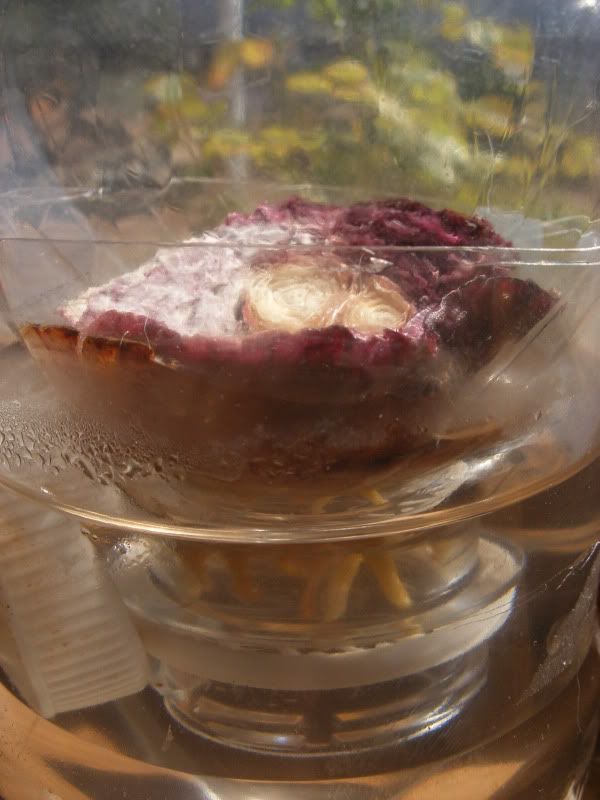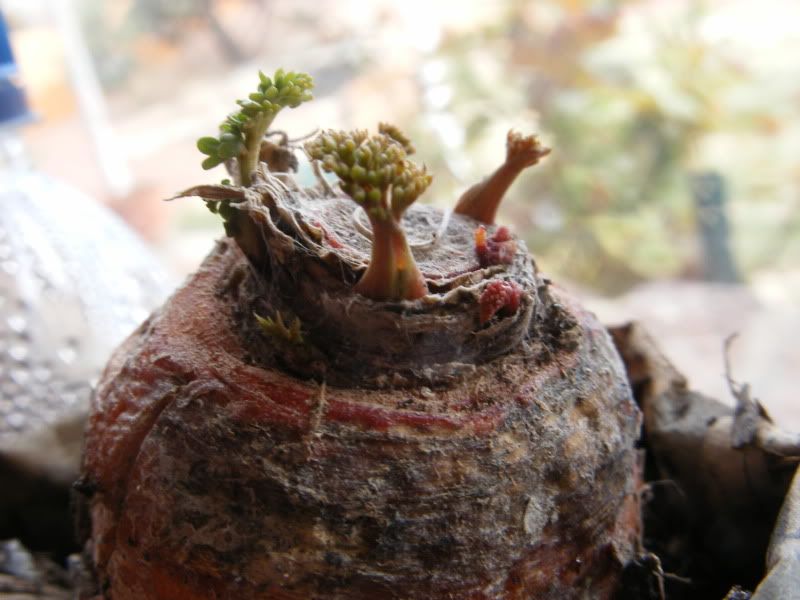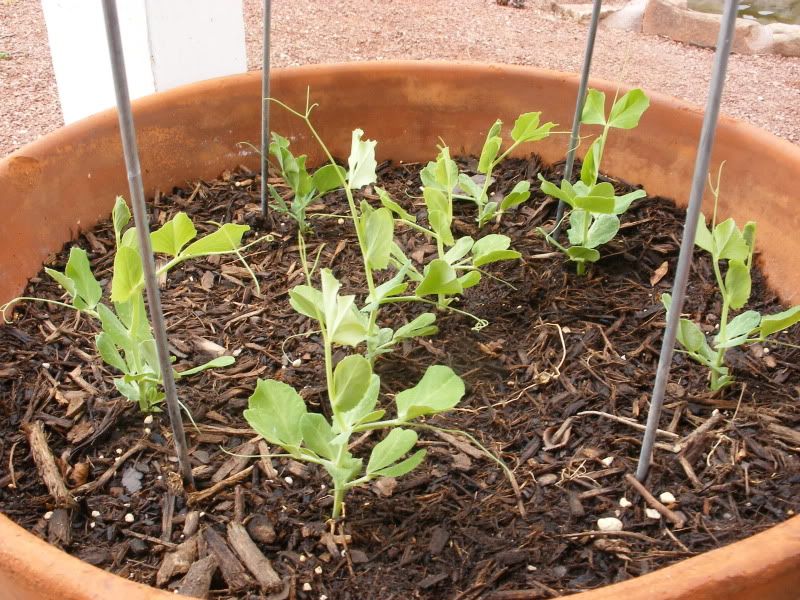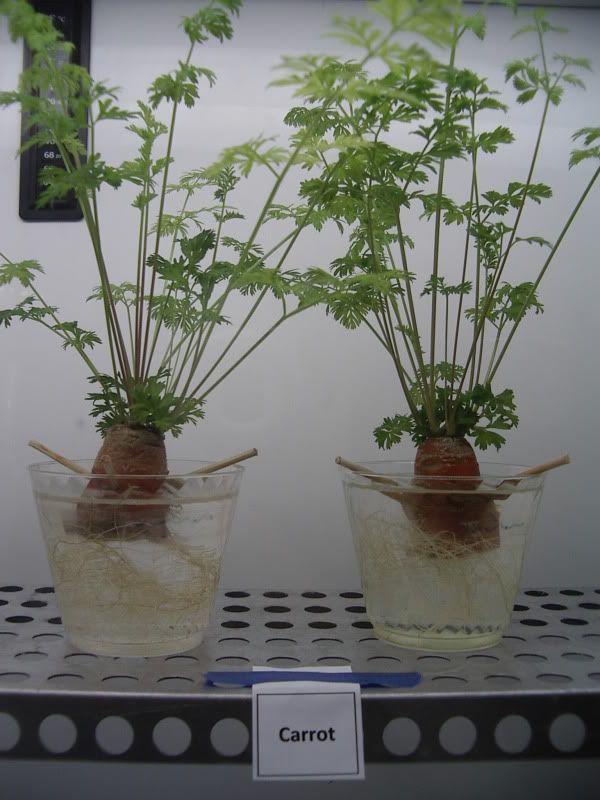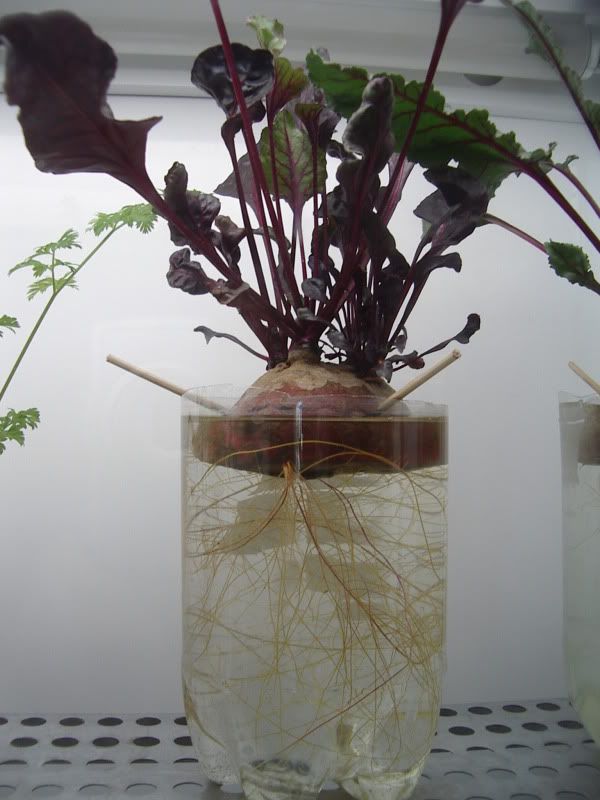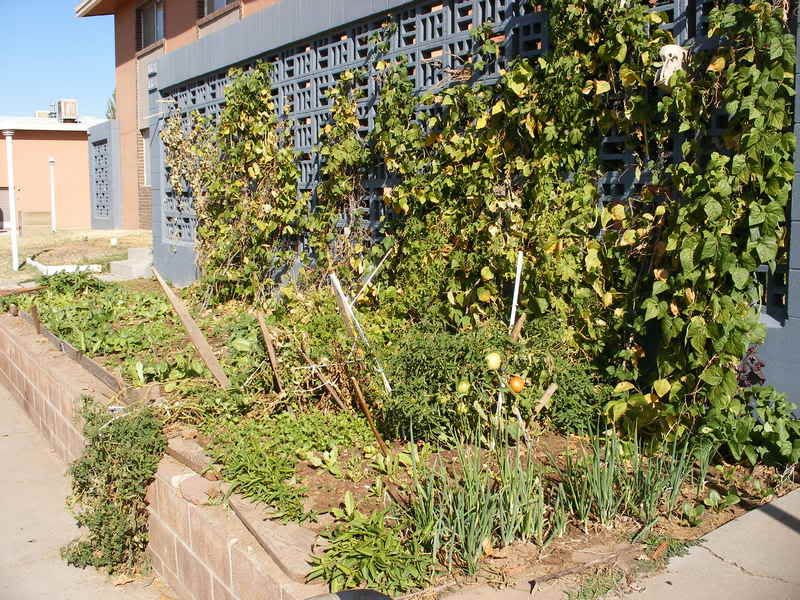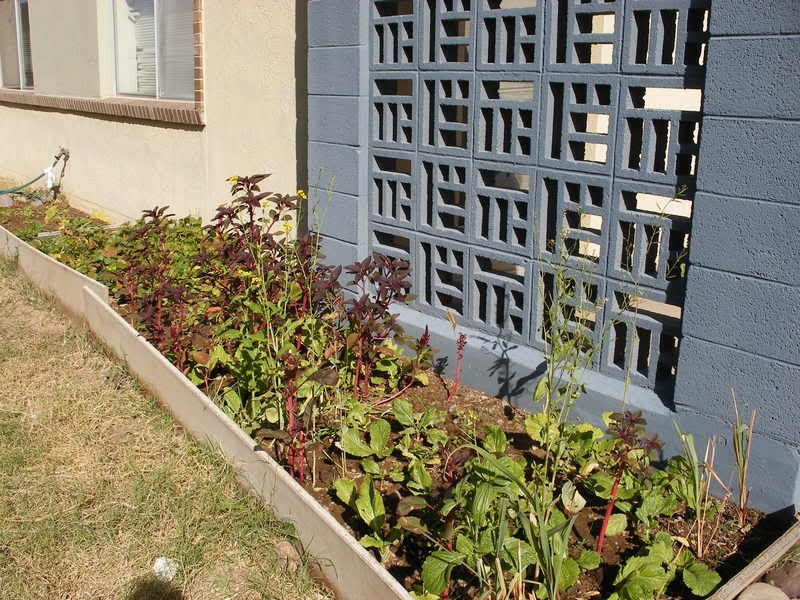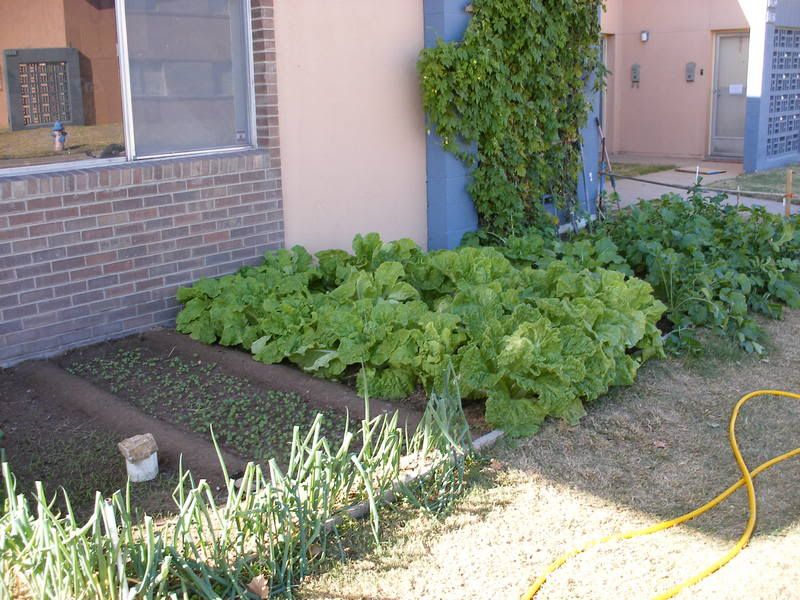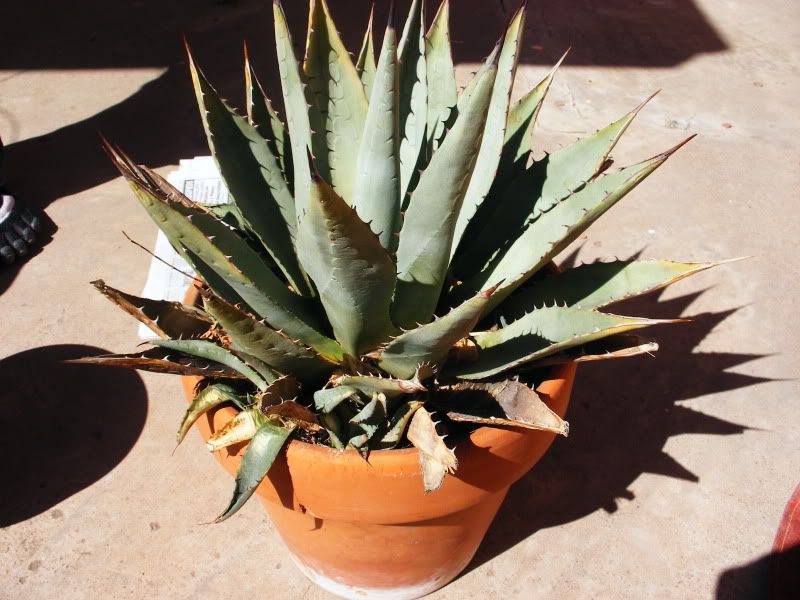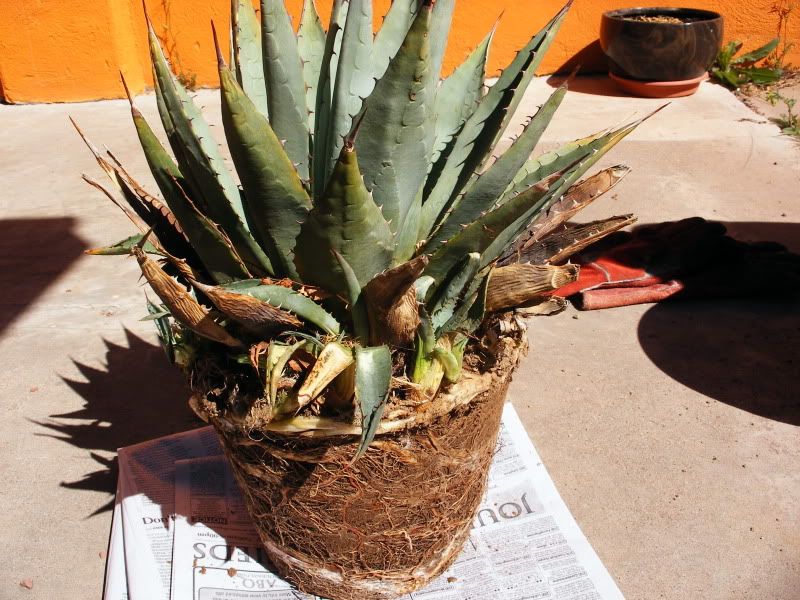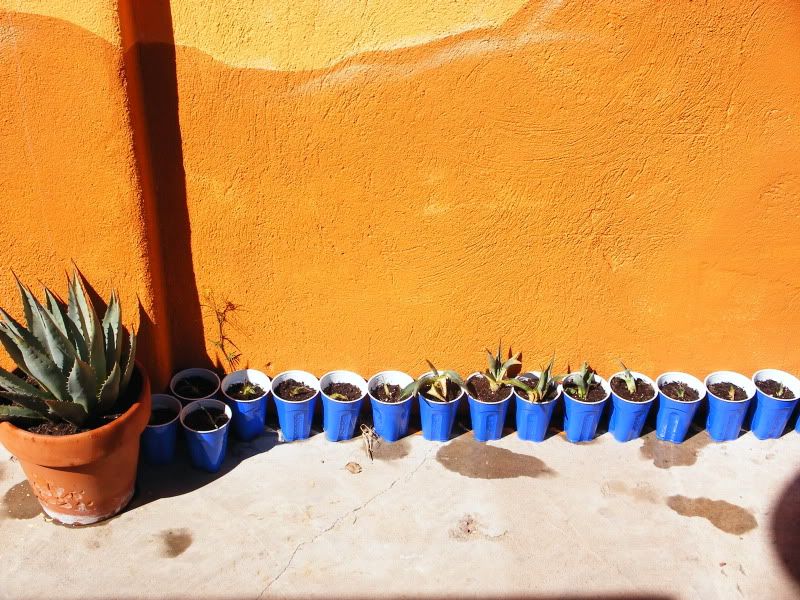In addition to pruning roses for my in-laws, planting gardens for friends, experimenting with propagation, and planting some things of my own, I've been tending a secret garden that no one else knows about. Well, tending probably isn't the right word. I've just been watering it and admiring it. I found it, around the side of the house, when I was situating my worm bin. Can you see it?
It becomes a little more obvious if you step up onto a pile of brick. You see, my secret garden is hidden from view, up above eye level. That's why it's just mine.
Yes, it's just a pile of moss growing on the chimney. For many of you, that might not be that special. But many of you don't live in New Mexico. It's too hot and dry for moss to really grow much around here. The closest thing I frequently find get is the lichen that grows on my beloved Watermelon Mountains. So finding a patch of fuzzy moss is a rare and special thing.
Of course, since it's a tiny garden filled with small non-vascular plants it helps to get up close to really appreciate it. Moss is so interesting. It's fuzzy and slightly squishy. It comes in variety of textures and colors.
And then there are the "flowers". When it spores the moss sends up little stocks which can look like flowers dotting a grassy hill. The different kinds of moss even seem to send up different stocks.
Unfortunately this garden probably won't last the whole year. I'm betting that even with my extra care it will get too hot this summer. The moss will dry up and die. My secret little garden will become a brown, barren place. At least until fall or maybe next spring. Then it will be cool enough and moisture will collect. I'm sure at that point a new crop of moss will spring to life!
Monday, April 25, 2011
More Scraps
I just wrapped up another experiment in kitchen scrap propagation. My subjects this time were an inch off the top of a carrot and an inch off the bottom of an onion. Both vegetables were suspended in water in soda bottle greenhouses*, using the inverted top to hold them at the water's surface. I can report one possible success and and one failure.
The carrot did not really show much growth. There may have been a hint of leaf production but nothing substantial and no root development. The portion of the carrot the remained submerged looked rather nice, though it had a mildly slimy texture by the end of the experiment. The top portion of the carrot shrivelled up and discolored. Next time I plan to keep just the stem part out of the water. Next time I also need to find another way of suspending the carrot, as it kept tipping over in the bottle's neck when I changed the water.
The onion seemed to be growing. There were, at least, roots forming, as seen in the photo. There was no indication of top growth, suggesting that next time I need to leave more onion on the scrap. The onion, too, would benefit from being suspended in a different way. In this case tipping wasn't an issue but the outer layer of the onion that was in constant contact with the bottle began to rot. The onion is buried in the carrot bed next to my mystery garlic. We'll see if it survives being planted out and grows.
*I will have to make a post dedicated to these. Probably in the fall when there aren't so many interesting growing things to post about.
The carrot did not really show much growth. There may have been a hint of leaf production but nothing substantial and no root development. The portion of the carrot the remained submerged looked rather nice, though it had a mildly slimy texture by the end of the experiment. The top portion of the carrot shrivelled up and discolored. Next time I plan to keep just the stem part out of the water. Next time I also need to find another way of suspending the carrot, as it kept tipping over in the bottle's neck when I changed the water.
The onion seemed to be growing. There were, at least, roots forming, as seen in the photo. There was no indication of top growth, suggesting that next time I need to leave more onion on the scrap. The onion, too, would benefit from being suspended in a different way. In this case tipping wasn't an issue but the outer layer of the onion that was in constant contact with the bottle began to rot. The onion is buried in the carrot bed next to my mystery garlic. We'll see if it survives being planted out and grows.
I probably would have allowed the onion to grow more before moving it but I need the green house for another experiment (seed starting for a three sisters garden). Stay tuned for more scraps!
*I will have to make a post dedicated to these. Probably in the fall when there aren't so many interesting growing things to post about.
Friday, April 22, 2011
Garden as Memorial
My grandfather, who's garden I have written about before, suffered a massive and unexpected heart attack and died recently. I've spent the past two weekends down in the city of the City of the Crosses helping out my grandmother in any way I can. I don't know if this is normal, but for our family that means yard-work.
I helped my father do some heavy pruning on a fig tree that suffered some damage this past winter. I built row covers to keep rabbits out of the vegetable beds. I helped tie back my grandmother's favourite rose to protect it from the 60 mph winds. I did it all because I know it's what my grandfather would have been doing.
Nor was I the only one. When the kids next door heard what had happened, they marched over, solemnly hugged my grandmother, and announced that they would weed her garden for her this summer. It was touching how, after years of playing in the garden, they knew exactly how they could help. They also swept her porch and planted seeds in a vegetable bed.
My grandfather once told me that two things in his life made him more proud than anything else. First, that he had raised four good daughters. Secondly, that he had positively impacted at least one plot of land. He viewed his garden as a form of stewardship to the earth and liked to think that he had made a lasting mark, by improving the soil, in that area.
The garden was once one of his passions, a joyous project. I hope that now it will continue to grow as a living memorial to him. I hope that as my grandmother, myself, the kids, and other continue to tend the garden we will also be tending our memories of him. I hope that neighbours walking past the garden will think of him. I hope the garden continues to grow for a long time.
I helped my father do some heavy pruning on a fig tree that suffered some damage this past winter. I built row covers to keep rabbits out of the vegetable beds. I helped tie back my grandmother's favourite rose to protect it from the 60 mph winds. I did it all because I know it's what my grandfather would have been doing.
Nor was I the only one. When the kids next door heard what had happened, they marched over, solemnly hugged my grandmother, and announced that they would weed her garden for her this summer. It was touching how, after years of playing in the garden, they knew exactly how they could help. They also swept her porch and planted seeds in a vegetable bed.
My grandfather once told me that two things in his life made him more proud than anything else. First, that he had raised four good daughters. Secondly, that he had positively impacted at least one plot of land. He viewed his garden as a form of stewardship to the earth and liked to think that he had made a lasting mark, by improving the soil, in that area.
The garden was once one of his passions, a joyous project. I hope that now it will continue to grow as a living memorial to him. I hope that as my grandmother, myself, the kids, and other continue to tend the garden we will also be tending our memories of him. I hope that neighbours walking past the garden will think of him. I hope the garden continues to grow for a long time.
Monday, April 18, 2011
Gardens I Have Known: Part 4
At my last apartment I had a nice little garden. This garden, I think, epitomises me as gardener right now. It was poorly planned, badly timed, and improperly utilized but still beautiful, ambitious, resourceful, and a heck of a lot of fun.
We moved into the apartment at the very beginning of July. This is not, of course, the right time to start a garden. Still, I started working on it, claiming that I was just going to start preparing the soil. I would weed it, turn it over, and maybe have it ready for some fall crops. That is not what ended up happening.
About the same time I finished pulling out the mess of dead wildflowers, left by the previous tenant, some tomatoes, ready for transplant, appeared on the break room table at work. Of course, I couldn't turn them down so I carried home one "Cuor Di Bue" and planted it. But one tomato looked lonely so I searched for other plants to add in.
I acquired mint, thyme, oregano, garlic, and chives from my mother's garden. Free first, cheap second, as the saying goes. I swung by Lowe's for some soaker hose and just had to pick up some other plants while I was there. I got two more tomatoes (Mr. Stripey and Patio), two chili peppers (NM Big Jim and Garden Salsa), Thai Basil, and Flat-leafed Parsley, and a Cucumber for a big pot. That Saturday I could help adding a Fennel and a Rosemary from the farmers market. In September I dug up another patch and planted Daylilies that I helped my mother divide out of her yard along with Cauliflower, Radishes, and as mix of Lettuce.
I laid down soaker hose and mulched it well with free grass clipping. Tending this little garden was my favourite escape. My neighbours all praised it and thought about digging up the lawn in front of their apartments too, though no one actually got around to it.
Ultimately, some of the plants did well and some did not. The cucumber was productive. The chili plants gave us more chili than I could really use. I got a huge bowl of radishes that I offered to the neighbours. The rosemary, on the other hand, dried up. The parsley shrivelled up. The cauliflower was devoured by caterpillars and the lettuce never did much of anything. Worst of all, the tomatoes never ripened. I picked a huge bowl of green tomato-marbles before frost to no avail.
Then, in January, we moved out. What would have happened this year if it were still my garden and I could start on time? Would the daylilies have established themselves? Would the garlic have come up? Could I have gotten tomatoes this year?
I gained alot in that garden. I started a worm bin that will enrich my future gardens. I began to learn how to make due with what I have available, both physically and time-wise. I think in that garden I actually became a gardener.
So, where do I go from here? Surely this isn't going to be the high point of my gardening experience. I should just be the beginning. The metaphorical plant have finally established themselves in the garden of my mind and now I should look forward to a long summer of lush growth. That's what this blog is for, tracking the physical blooms of my mind-garden. I can't wait till my mind sets fruit.
We moved into the apartment at the very beginning of July. This is not, of course, the right time to start a garden. Still, I started working on it, claiming that I was just going to start preparing the soil. I would weed it, turn it over, and maybe have it ready for some fall crops. That is not what ended up happening.
About the same time I finished pulling out the mess of dead wildflowers, left by the previous tenant, some tomatoes, ready for transplant, appeared on the break room table at work. Of course, I couldn't turn them down so I carried home one "Cuor Di Bue" and planted it. But one tomato looked lonely so I searched for other plants to add in.
I acquired mint, thyme, oregano, garlic, and chives from my mother's garden. Free first, cheap second, as the saying goes. I swung by Lowe's for some soaker hose and just had to pick up some other plants while I was there. I got two more tomatoes (Mr. Stripey and Patio), two chili peppers (NM Big Jim and Garden Salsa), Thai Basil, and Flat-leafed Parsley, and a Cucumber for a big pot. That Saturday I could help adding a Fennel and a Rosemary from the farmers market. In September I dug up another patch and planted Daylilies that I helped my mother divide out of her yard along with Cauliflower, Radishes, and as mix of Lettuce.
I laid down soaker hose and mulched it well with free grass clipping. Tending this little garden was my favourite escape. My neighbours all praised it and thought about digging up the lawn in front of their apartments too, though no one actually got around to it.
Ultimately, some of the plants did well and some did not. The cucumber was productive. The chili plants gave us more chili than I could really use. I got a huge bowl of radishes that I offered to the neighbours. The rosemary, on the other hand, dried up. The parsley shrivelled up. The cauliflower was devoured by caterpillars and the lettuce never did much of anything. Worst of all, the tomatoes never ripened. I picked a huge bowl of green tomato-marbles before frost to no avail.
Then, in January, we moved out. What would have happened this year if it were still my garden and I could start on time? Would the daylilies have established themselves? Would the garlic have come up? Could I have gotten tomatoes this year?
I gained alot in that garden. I started a worm bin that will enrich my future gardens. I began to learn how to make due with what I have available, both physically and time-wise. I think in that garden I actually became a gardener.
So, where do I go from here? Surely this isn't going to be the high point of my gardening experience. I should just be the beginning. The metaphorical plant have finally established themselves in the garden of my mind and now I should look forward to a long summer of lush growth. That's what this blog is for, tracking the physical blooms of my mind-garden. I can't wait till my mind sets fruit.
Wednesday, April 13, 2011
How Not to Grow a Carrot
This is just a quick update to my kitchen scrap gardening experiment.
I wanted to see if a carrot would regrow from a carrot top if it were placed in potting soil. I put the potting soil in a newspaper pot to ease the transplant shock from eventually moving it out into the garden and contained the whole thing in a soda bottle greenhouse to keep it moist. I set it on a sunny windowsill and waited.
I don't think, now, that this is the best way to grow carrots. While there are some leaves beginning to emerge from the carrot, there are no roots and the the whole thing look and smells bad. I suspect that the greenhouse is at fault, keeping everything a little too moist.
Time to try something new.
I wanted to see if a carrot would regrow from a carrot top if it were placed in potting soil. I put the potting soil in a newspaper pot to ease the transplant shock from eventually moving it out into the garden and contained the whole thing in a soda bottle greenhouse to keep it moist. I set it on a sunny windowsill and waited.
I don't think, now, that this is the best way to grow carrots. While there are some leaves beginning to emerge from the carrot, there are no roots and the the whole thing look and smells bad. I suspect that the greenhouse is at fault, keeping everything a little too moist.
Time to try something new.
Friday, April 8, 2011
Garden Update: April Showers
Yesterday, in the aftermath of the first precipitation we've have in months, I went out to take stock of my little plants. Most of them are doing great. I'm suspect that this will be a good year.
There's nothing quite like peas. They are the heralds of spring! They grow before most of the other vegetables and the way the seem to stretch up toward the sky lift my heart. There are about seven plants in each pot and as usual, I'm afraid I over planted a bit. The peas in both pots seem to be doing great though. A few of them have grabbed hold of the tomato cage I stuck in their pot.
The radishes are doing great. They're beginning to look like actual plants. Time to thin out the dense spots a bit. Even more exciting in this bed, the carrots have sprouted! Back in my college garden I sowed carrots every year and only once got any to germinate so it's thrilling to have some success this year. I planted a rainbow mix this year so I've been looking carefully for differences in the leaves of my carrot plants. Some of them appear to have normal looking round cotyledon while others came up long and thin, like grass. I only assume that they are both carrots because they both came up en masse at about the same time and they're both now sporting their first sets of true carrot leaves. There's one other surprise in the radish-carrot bed. Something came up with the radishes that is clearly neither a radish nor a carrot. I let it grow because I was curious. I don't know what my in-laws planted in this bed last year but it looks like a very large grass right now. Any guesses?
The agave that I repotted is not looking so good. It, and most of it's pups, have lost their happy green-blue color. Now it mostly matches the wall. In the research that I've done since the repoting, it looks like I shouldn't have watered them all after I was finished and I should have left them under the porch instead of against a sunny wall. Live and learn, I guess. I'm still hoping that it's succulent constitution will give it the strength to survive.
Lastly, two weeks ago I threw some seeds into the planter around the mailbox out front. I didn't record the varieties and threw away the seed packets so I don't know exactly what I put in there. I know there were some nasturtiums because, as I've said before, I'm curious how they do in our dry climate and I wish that everything I planted I could eat. There were also some snapdragons because their color matched the nasturtiums and I know my mother-in-law likes them. I also added in some sort of red lettuce for two reasons. First, I thought the colored foliage would look nice with the flowers and secondly, I really like mixing flowers and vegetables. The second reason goes against my mother-in-law's gardening ideas so I guess a minor act of rebellion is a third reason. We'll see if she notices. Yesterday, I noticed that something, one tiny little cotyledon, was poking out of the soil. It is, of course, way to small and immature to identify so we'll just have to wait to see what's coming up out there.
There's nothing quite like peas. They are the heralds of spring! They grow before most of the other vegetables and the way the seem to stretch up toward the sky lift my heart. There are about seven plants in each pot and as usual, I'm afraid I over planted a bit. The peas in both pots seem to be doing great though. A few of them have grabbed hold of the tomato cage I stuck in their pot.
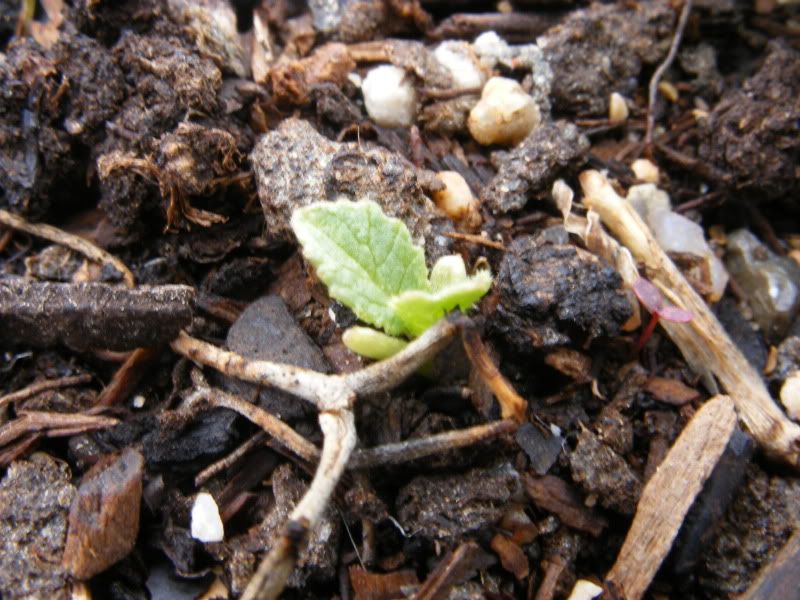 |
| Carrot with round cotyledon. |
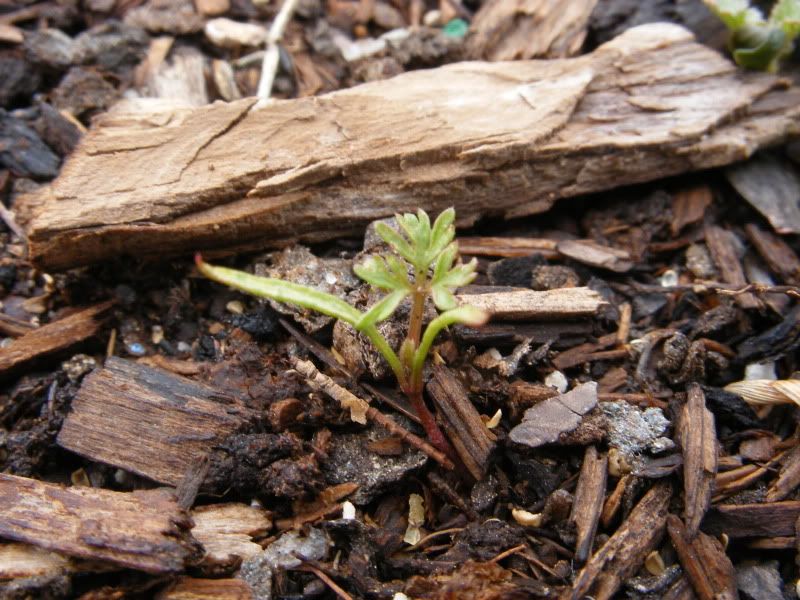 |
| Carrot with elongated cotyledon. |
The agave that I repotted is not looking so good. It, and most of it's pups, have lost their happy green-blue color. Now it mostly matches the wall. In the research that I've done since the repoting, it looks like I shouldn't have watered them all after I was finished and I should have left them under the porch instead of against a sunny wall. Live and learn, I guess. I'm still hoping that it's succulent constitution will give it the strength to survive.
Lastly, two weeks ago I threw some seeds into the planter around the mailbox out front. I didn't record the varieties and threw away the seed packets so I don't know exactly what I put in there. I know there were some nasturtiums because, as I've said before, I'm curious how they do in our dry climate and I wish that everything I planted I could eat. There were also some snapdragons because their color matched the nasturtiums and I know my mother-in-law likes them. I also added in some sort of red lettuce for two reasons. First, I thought the colored foliage would look nice with the flowers and secondly, I really like mixing flowers and vegetables. The second reason goes against my mother-in-law's gardening ideas so I guess a minor act of rebellion is a third reason. We'll see if she notices. Yesterday, I noticed that something, one tiny little cotyledon, was poking out of the soil. It is, of course, way to small and immature to identify so we'll just have to wait to see what's coming up out there.
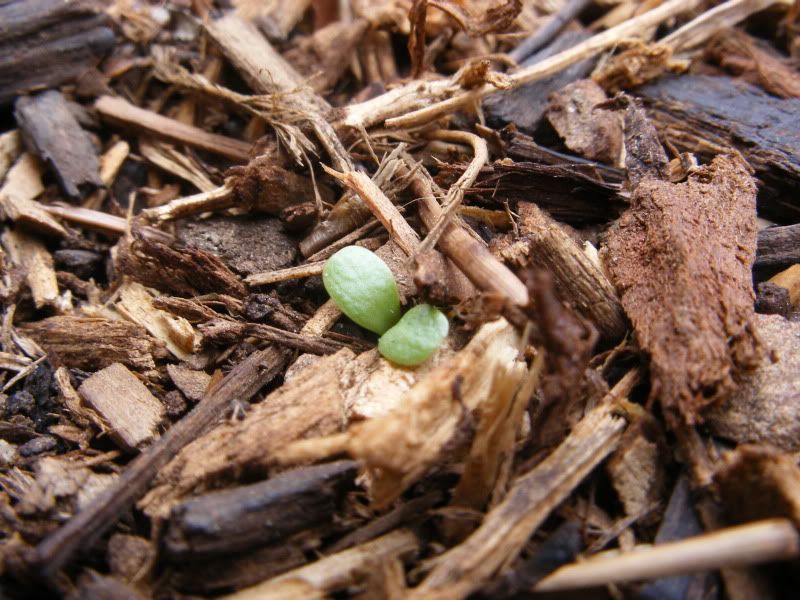 |
| What is it? |
Labels:
agave,
carrot,
garlic,
lettuce,
nasturtium,
pea,
plants,
radish,
snapdragon
Wednesday, April 6, 2011
Kitchen Scrap Gardening?
Imagine for a moment that you've bought some carrots at the supermarket to make pot pies. Most of the carrot, of course, gets diced up, cooked, and eaten. If you're a gardener then the peelings should already be headed to you compost pile to be broken down into good stuff for your plants. But if you really want to squeeze a little more usefulness out of that carrot, perhaps you can save the top and grow a whole new carrot!
This is a prime example of why I am, perhaps more than any other adjective, a frugal gardener. Anything that I can acquire, repurpose, or make for free I will.
I remember first coming across this notion in an old children's book of projects*. It suggested using both carrot tops in a tray of water and a sweet potato suspended in a glass to grow an indoor jungle. I must have tried the carrot-in-a-tray idea a dozen times growing up but it never worked for me. Usually the carrot dried out and the cat was blamed for drinking all the water.
Now, however, I can now report some success! In January I set up an experiment at a local children's museum to see if the tops of carrots (and some other, similarly structured vegetables) would grow in glasses of water. All the samples were prepared similarly, with most of the root and any leaves removed before being suspended in a glass of water. The water was refilled as needed and completely changed a couple of times a week. Here are the results so far!
The carrots seem to be preforming best. As seen in the photo, both carrots have lots of leaves and roots filling their cups. It is important to note that the carrots in a manner very different to the other samples. They produced roots fairly quickly (a week or two, I believe) but didn't put out any leaves for at least a month.
One of the two radishes is doing well. It produced new leaves quickly, followed by root growth. The other radish reportedly turned to goo within a week and was thrown out.
Only one of the two turnips is shown, though both turnip tops produced leaves and then roots. The turnip shown quickly sent out lots of leaves and roots, followed by a tall stalk that now has small flowers at the top. After two months some of the leaves it first produced started dying.
The beets needed to be watched closely. For the first month they tended to leech red pigment into their water and grow a slime where they contacted the water. This was regularly rinsed off. The beet shown sent out leaves within a week followed by roots soon after. The other beet grew leaves just as fast but didn't produce any roots until two months later.
While these results demonstrate that the discarded tops of root vegetables can grow new leaves and roots, they do not yet show that they are capable of regrowing the tap root that we would like to harvest (aside from the possibility of eating the turnip and beet greens). Will these carrots ever produce a new carrot? I don't know yet.
Other questions remain also. Will the vegetable tops root in soil in addition to water? What other vegetables can grow this way? I have read that onions can be grown in a similar way from their discarded bottom ends. I also remember reading somewhere that lettuce can grow again from their root ends. Pineapples can supposedly be grown from their discarded tops, though I've never had any luck with this. Avocados pits can, famously, be sprouted in a glass of water. What other grocery store produce can yield good seed?
*On a side note, if anyone can remember the title of that book, I would love to know. I remember it being illustrated in a style similar to P.D. Eastman, if that helps.
This is a prime example of why I am, perhaps more than any other adjective, a frugal gardener. Anything that I can acquire, repurpose, or make for free I will.
I remember first coming across this notion in an old children's book of projects*. It suggested using both carrot tops in a tray of water and a sweet potato suspended in a glass to grow an indoor jungle. I must have tried the carrot-in-a-tray idea a dozen times growing up but it never worked for me. Usually the carrot dried out and the cat was blamed for drinking all the water.
Now, however, I can now report some success! In January I set up an experiment at a local children's museum to see if the tops of carrots (and some other, similarly structured vegetables) would grow in glasses of water. All the samples were prepared similarly, with most of the root and any leaves removed before being suspended in a glass of water. The water was refilled as needed and completely changed a couple of times a week. Here are the results so far!
The carrots seem to be preforming best. As seen in the photo, both carrots have lots of leaves and roots filling their cups. It is important to note that the carrots in a manner very different to the other samples. They produced roots fairly quickly (a week or two, I believe) but didn't put out any leaves for at least a month.
One of the two radishes is doing well. It produced new leaves quickly, followed by root growth. The other radish reportedly turned to goo within a week and was thrown out.
Only one of the two turnips is shown, though both turnip tops produced leaves and then roots. The turnip shown quickly sent out lots of leaves and roots, followed by a tall stalk that now has small flowers at the top. After two months some of the leaves it first produced started dying.
The beets needed to be watched closely. For the first month they tended to leech red pigment into their water and grow a slime where they contacted the water. This was regularly rinsed off. The beet shown sent out leaves within a week followed by roots soon after. The other beet grew leaves just as fast but didn't produce any roots until two months later.
While these results demonstrate that the discarded tops of root vegetables can grow new leaves and roots, they do not yet show that they are capable of regrowing the tap root that we would like to harvest (aside from the possibility of eating the turnip and beet greens). Will these carrots ever produce a new carrot? I don't know yet.
Other questions remain also. Will the vegetable tops root in soil in addition to water? What other vegetables can grow this way? I have read that onions can be grown in a similar way from their discarded bottom ends. I also remember reading somewhere that lettuce can grow again from their root ends. Pineapples can supposedly be grown from their discarded tops, though I've never had any luck with this. Avocados pits can, famously, be sprouted in a glass of water. What other grocery store produce can yield good seed?
*On a side note, if anyone can remember the title of that book, I would love to know. I remember it being illustrated in a style similar to P.D. Eastman, if that helps.
Monday, April 4, 2011
Gardens I Have Known: Part 3
This covers not a single garden but a whole gardening community. It is also about the first garden that was actually mine. There are small plants, big ideas, and casual acts of sedition.
While attending the state university in the City of the Crosses I lived in the student family housing. This was unusual because I was not married and did not have children but the university allowed it because they had more housing than families. This worked well for me because I enjoyed having my own room, a neighbourhood full of families and children, and the quieter living that can't take place in the dorms.
Many of the other occupants of the student family housing were, for whatever reason, Asian families much larger than the standard American nuclear family. And most of these families, independently and without any organizing force, maintained gardens tended by the older members of the family. I believe that these gardens (I counted more than thirty of them at one point) had a profound effect on the feel of the neighbourhood. What could have been little more than a complex of units, storing students when they weren't in class, was turned into a pleasant place where people and plants both grew to be useful.
Almost all of these gardens overgrew the small walled-in yards attached to each housing unit, spilling over into the more communal grassy areas near the sidewalks. Year round there were both common and exotic greens, peppers, and other vegetables growing and being harvested all around the neighbourhood. Tomatoes and peppers were always drying in the sun atop mailboxes and green utility boxes. Where the University had intended bermuda and crab grass to grow I got to see Bok Choy and Bitter Melons being cultivated.
You may have noticed the conflict in that last sentence. There was a difference between the University's intention and what was being done with the land. I don't believe that the gardeners saw it as an act of rebellion (There was land that wasn't really being used, so they put it to good use) but they went against the University with every seed they planted. They were, unwittingly, an army of guerilla gardeners. Frequently there were notices posted on every door in the neighbourhood stating that gardens were not allowed outside of the yards provided. As near as I could tell, though, this never stopped anyone.
In the midst of all this excitement and inspiration I decided to plant my first garden. With tools borrowed from my grandparents I painstakingly pulled up all the weeds and grass rooted in my little yard. I turned as much manure and garden soil as I could buy into the sandy soil. I laid down pathways and boarders built from rocks and bricks that I scrounged from around the neighbourhood. I planted radishes, carrots, beets, lettuce, spinach, peas, swiss chard, and anything else I though would be ready to harvest before the end of the semester.
Very little actually grew in my garden. Perhaps there was just never enough organic matter in the soil. Maybe I didn't water it well enough. It could be that I just planted everything at the wrong times. Whatever the reason, in the four years I worked on that garden I think I probably harvested no more than 6 woody carrots, one swiss chard plant, three pounds of snap peas, and a few leaves of parsley. It was never exactly the urban farm I had hoped for after seeing what my neighbours grew.
Still, I think fondly of those gardens. I admire the ingenuity and perseverance of those gardeners. Someday I hope to tend a garden that is a riot of produce like theirs. Even though I have never tasted one, that garden will probably include Bitter Melons, my personal symbol of true guerilla gardening.
While attending the state university in the City of the Crosses I lived in the student family housing. This was unusual because I was not married and did not have children but the university allowed it because they had more housing than families. This worked well for me because I enjoyed having my own room, a neighbourhood full of families and children, and the quieter living that can't take place in the dorms.
Many of the other occupants of the student family housing were, for whatever reason, Asian families much larger than the standard American nuclear family. And most of these families, independently and without any organizing force, maintained gardens tended by the older members of the family. I believe that these gardens (I counted more than thirty of them at one point) had a profound effect on the feel of the neighbourhood. What could have been little more than a complex of units, storing students when they weren't in class, was turned into a pleasant place where people and plants both grew to be useful.
Almost all of these gardens overgrew the small walled-in yards attached to each housing unit, spilling over into the more communal grassy areas near the sidewalks. Year round there were both common and exotic greens, peppers, and other vegetables growing and being harvested all around the neighbourhood. Tomatoes and peppers were always drying in the sun atop mailboxes and green utility boxes. Where the University had intended bermuda and crab grass to grow I got to see Bok Choy and Bitter Melons being cultivated.
You may have noticed the conflict in that last sentence. There was a difference between the University's intention and what was being done with the land. I don't believe that the gardeners saw it as an act of rebellion (There was land that wasn't really being used, so they put it to good use) but they went against the University with every seed they planted. They were, unwittingly, an army of guerilla gardeners. Frequently there were notices posted on every door in the neighbourhood stating that gardens were not allowed outside of the yards provided. As near as I could tell, though, this never stopped anyone.
In the midst of all this excitement and inspiration I decided to plant my first garden. With tools borrowed from my grandparents I painstakingly pulled up all the weeds and grass rooted in my little yard. I turned as much manure and garden soil as I could buy into the sandy soil. I laid down pathways and boarders built from rocks and bricks that I scrounged from around the neighbourhood. I planted radishes, carrots, beets, lettuce, spinach, peas, swiss chard, and anything else I though would be ready to harvest before the end of the semester.
Very little actually grew in my garden. Perhaps there was just never enough organic matter in the soil. Maybe I didn't water it well enough. It could be that I just planted everything at the wrong times. Whatever the reason, in the four years I worked on that garden I think I probably harvested no more than 6 woody carrots, one swiss chard plant, three pounds of snap peas, and a few leaves of parsley. It was never exactly the urban farm I had hoped for after seeing what my neighbours grew.
Still, I think fondly of those gardens. I admire the ingenuity and perseverance of those gardeners. Someday I hope to tend a garden that is a riot of produce like theirs. Even though I have never tasted one, that garden will probably include Bitter Melons, my personal symbol of true guerilla gardening.
Friday, April 1, 2011
Repotting an Agave
Of all the things the previous occupant of my last apartment left behind, my favourite was a potted Agave. I've never had much luck with potted plants and never seen much point in plants that aren't useful but the Agave was looked pretty and hardy and was free. Unfortunately, judging by the pups squeezing their way out from under the parent plant, the Agave needed to be repotted.
This chore scared me in a number of ways. I have very little experience with repotting plants, so the odds of killing it in the process seemed high. Furthermore, the Agave is a large, spiny, dense plant so the odds of injuring myself seemed equally high. So I put it off for a year.
Now that the days are warm again and the Agave has survived my neglect for a whole year, I felt that it deserved some care. With the help of my wife (who got stabbed instead of me) I've finally done it.
We started by removing the Agave from it's pot. This took the form of a dangerous tug-of-war, myself gripping the dead leaves around the base while my wife struggled with the pot. Once freed, it was apparent just how badly root bound the poor plant was.
I carefully began untangling roots, cutting off far more pups than I expected as I came across them. The pups were attached to the parent plant by way of long ropey looking growths which I mostly cut off and discarded.
In the end I had eighteen pups, removed and potted in plastic ups (with holes in the bottoms, of course). The Agave returned to it's original pot, it's roots trimmed down by about half.
Will any of these survive being manhandled? I hope so. When I feel certain which ones are going to survive, I will make another post here offering them up to any local gardener who cares to claim one. I certainly don't have a need for so many Agave.
This chore scared me in a number of ways. I have very little experience with repotting plants, so the odds of killing it in the process seemed high. Furthermore, the Agave is a large, spiny, dense plant so the odds of injuring myself seemed equally high. So I put it off for a year.
Now that the days are warm again and the Agave has survived my neglect for a whole year, I felt that it deserved some care. With the help of my wife (who got stabbed instead of me) I've finally done it.
We started by removing the Agave from it's pot. This took the form of a dangerous tug-of-war, myself gripping the dead leaves around the base while my wife struggled with the pot. Once freed, it was apparent just how badly root bound the poor plant was.
I carefully began untangling roots, cutting off far more pups than I expected as I came across them. The pups were attached to the parent plant by way of long ropey looking growths which I mostly cut off and discarded.
In the end I had eighteen pups, removed and potted in plastic ups (with holes in the bottoms, of course). The Agave returned to it's original pot, it's roots trimmed down by about half.
Will any of these survive being manhandled? I hope so. When I feel certain which ones are going to survive, I will make another post here offering them up to any local gardener who cares to claim one. I certainly don't have a need for so many Agave.
Subscribe to:
Posts (Atom)








